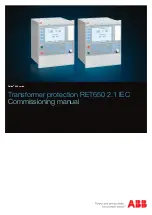
Restricted earth fault
When the transformer's earthed side is compensated with afore-mentioned zero sequence
compensation, that side will be a third (appr. 33 %) less sensitive in detecting single-phase faults inside
the differential zone. For this reason it is advised that the restricted earth fault (REF) stage is activated
on the transformer side that compensates the zero sequence current. Additionally, it should be enabled
whenever the Y side of the starpoint is earthed; normal phase differential protection cannot be set to
provide the maximum sensitivity to detect single-phase (earth) faults within the differential are because
the properties dependant on the transformer and the application that were described in the previous
section. This differential stage monitors the incoming calculated residual current and compares it to the
outgoing starpoint current. If the single-phase (earth) fault occurs outside the differential zone, this
function does not operate; if the fault occurs inside the differential zone, this function operates quickly.
This protection's sensitivity to earth faults only within the protection zone is referred to as the "restricted
earth fault protection".
The transformer differential functions offers two stages of low-impedance, restricted earth fault
protection.
The operating characters of the restricted earth fault function (I0d>) on both the high voltage and the
low voltage side are more similar to each other than to the percentage characteristics presented by the
Idb> function, even though both sides are independent and can be set freely. The calculation of
differential and biasing currents on both sides is as follows (the HV side on the left, the LV side on the
right).
Similarly to the phase differential stages, both sides with the restricted earth fault stages have options
between the average and the maximum bias current calculation, as well as the option between the add
and the subtract current calculation. The use of these stages depends on the CTs' installation
directions and the desired sensitivity for bias calculation.
In the transformer differential stage the reference current for the REF protection is always the protected
side nominal current, which is calculated in the relay's Transformer status monitoring (TRF) module.
The transformer REF stage (regardless of the side) may be set to be a lot more sensitive than the
phase differential. The setting sensitivity should be defined by whether or not one expects CT
saturation (transformer's maximum single-phase output compared to the neutral point CT ratings). The
tripping characteristics may be set differently when the network is earthed either directly or through
impedance, and therefore the fault current may be expected to saturate the CTs even during external
faults. For this reason there are three sections also in the REF function characteristics (non-biased,
slightly biased, and heavily biased). For high-impedance or close-to-neutral winding faults the first (non-
biased) section should consider the CTs' possible measurement errors as well as the desired sensitivity
for internal faults close-to-neutral. The Turnpoint 1 setting should be twice the CT's nominal current.
Normally the setting calculation is guided by the primary-to-maximum current rating because the CTs'
neutral point has a lower primary current rating than the phase current. The first biased section (that is,
Slope 1) should consider how a possible saturation in the CTs' neutral point affects normal
(external) earth faults, and the how a heavy fault going fully through the second biased section (Slope
2) can cause saturation in the CTs' phase currents.
The recommended base settings:
• Pick-up (base sensitivity): typically 5 % to 10 % of the phase current CT error (Px)
Genera
Generattor Commander
or Commander
Instruction manual
Version: 2.07
276
© Arcteq Relays Ltd
IM00001
Содержание Generator Commander
Страница 1: ...Generator Commander Instruction manual...
Страница 2: ......
















































